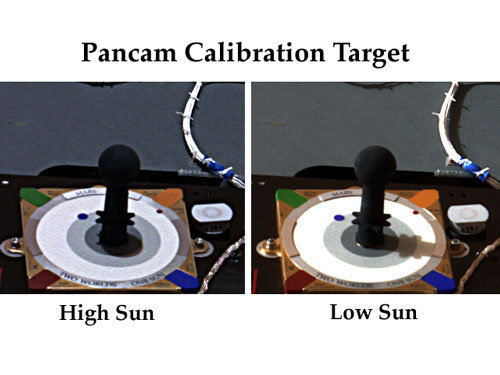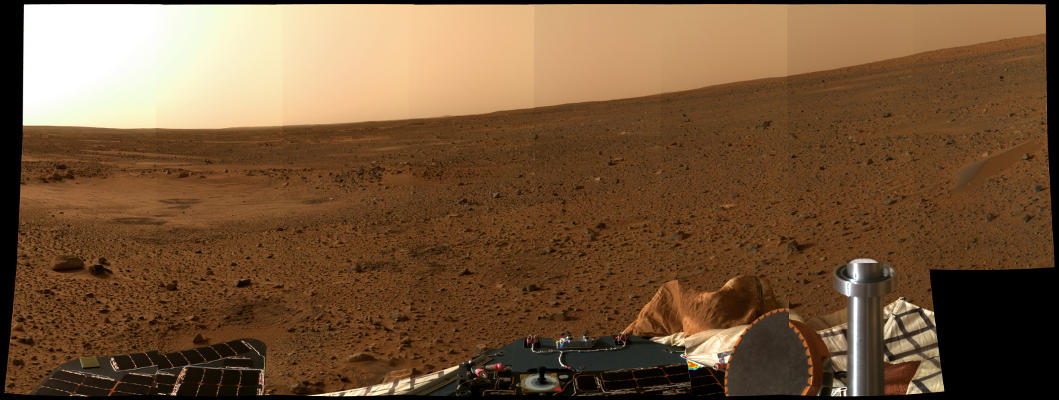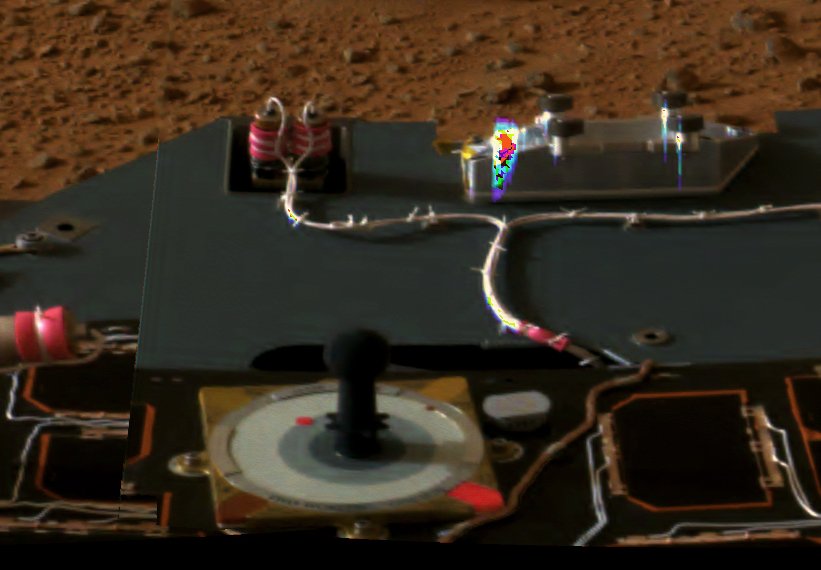It looks like you're using an Ad Blocker.
Please white-list or disable AboveTopSecret.com in your ad-blocking tool.
Thank you.
Some features of ATS will be disabled while you continue to use an ad-blocker.
share:
reply to post by Fisherr
Yeah. Just like on Earth.
Blue rocks? you mean the blue sky reflecting off the rocks
Yeah. Just like on Earth.
The sunlight interacting with the Earth's atmosphere makes the sky blue. In outer space the astronauts see blackness because outer space has no
atmosphere. Sunlight consists of light waves of varying wavelengths, each of which is seen as a different color. The minute particles of matter and
molecules of air in the atmosphere intercept and scatter the white light of the sun. A larger portion of the blue color in white light is scattered,
more so than any other color because the blue wavelengths are the shortest. When the size of atmospheric particles are smaller than the wavelengths of
the colors, selective scattering occurs-the particles only scatter one color and the atmosphere will appear to be that color. Blue wavelengths
especially are affected, bouncing off the air particles to become visible. This is why the sun looks yellow (yellow equals white minus blue). At
sunset, the sky changes color because as the sun drops to the horizon, sunlight has more atmosphere to pass through and loses more of its blue
wavelengths. The orange and red, having the longer wavelengths and making up more of sunlight at this distance, are most likely to be scattered by the
air particles.
The atmosphere of Mars is 95% carbon dioxide, 3% nitrogen, with a trace of methane, argon, water vapor and oxygen. The atmosphere of Mars extends out a little further than Earth's, probably because of its weaker gravity, but Mar's air pressure is only .087 psi at sea level compared to Earth's 14.8 psi. It's atmosphere is very, very thin. Now, since the density of the atmosphere is what causes sunlight to change color, wouldn't the relative thinness of Mars' atmosphere cause the sky to be a very pale whitish-blue color, rather than the muddy brown they always show. They say it is the dust in the atmosphere, but how could such a thin atmosphere hold that much dust, and where are the dust clouds? Consider also that the horizon is twice as close as on Earth, because Mars is only half the size. That means the light would be traveling, and scattering, through half as much atmospheric depth.
If Nasa is doctoring photos, why?
Mars with a blue sunset, as featured at wikipedia. The blue should only lighten to pale white during the day, not darken to orange. It doesn't make sense.
The atmosphere of Mars is 95% carbon dioxide, 3% nitrogen, with a trace of methane, argon, water vapor and oxygen. The atmosphere of Mars extends out a little further than Earth's, probably because of its weaker gravity, but Mar's air pressure is only .087 psi at sea level compared to Earth's 14.8 psi. It's atmosphere is very, very thin. Now, since the density of the atmosphere is what causes sunlight to change color, wouldn't the relative thinness of Mars' atmosphere cause the sky to be a very pale whitish-blue color, rather than the muddy brown they always show. They say it is the dust in the atmosphere, but how could such a thin atmosphere hold that much dust, and where are the dust clouds? Consider also that the horizon is twice as close as on Earth, because Mars is only half the size. That means the light would be traveling, and scattering, through half as much atmospheric depth.
If Nasa is doctoring photos, why?
Mars with a blue sunset, as featured at wikipedia. The blue should only lighten to pale white during the day, not darken to orange. It doesn't make sense.
Those blue rocks would probably be Mars' "blueberries". Martian spherules (also known as blueberries due to their blue hue in false-color images
released by NASA) are the abundant spherical hematite inclusions discovered by the Mars rover Opportunity at Meridiani Planum on the planet Mars. They
are found in situ embedded in a sulfate salt evaporitic matrix, and also loose on the surface.
en.wikipedia.org...
en.wikipedia.org...
reply to post by rodredux
cdn.physorg.com...
Mars has global dust storms.
science.nasa.gov...
How about dust devils reaching high, high, high?
news.discovery.com...
The surface pressure of Mars is about that of Earth's atmosphere at about 100,000 feet. Have you ever been in a jet? Even at only 30,000 feet the sky is dark blue. At 100,000 feet it would be a deep, deep blue (verging on black) and so would the sky of Mars if it weren't for the dust.
Mars is very dry and the dust is very fine. Dust clouds?
They say it is the dust in the atmosphere, but how could such a thin atmosphere hold that much dust, and where are the dust clouds?
cdn.physorg.com...
Mars has global dust storms.
science.nasa.gov...
How about dust devils reaching high, high, high?
news.discovery.com...
Good question. What would be the point?
If Nasa is doctoring photos, why?
The coloration of a clear atmosphere is caused by the preferential scattering of blue light (see Rayleigh scattering). Particles larger than molecular sizes (like dust) scatter other wavelengths.
The blue should only lighten to pale white during the day, not darken to orange.
The surface pressure of Mars is about that of Earth's atmosphere at about 100,000 feet. Have you ever been in a jet? Even at only 30,000 feet the sky is dark blue. At 100,000 feet it would be a deep, deep blue (verging on black) and so would the sky of Mars if it weren't for the dust.
edit on 8/8/2012 by Phage because: (no reason given)
reply to post by rodredux
That's right, in false color images the hematite spheres appear blue. Just as the sky can in false color images, depending on which filters are used to produce them. Just as the rocks in that image do.
That's right, in false color images the hematite spheres appear blue. Just as the sky can in false color images, depending on which filters are used to produce them. Just as the rocks in that image do.
edit on 8/8/2012 by Phage because: (no reason given)
Thanks, Phage. I read an article about moon dust as well. Seems there is dust floating around even on the moon. The dust gets magnetically charged by
radiation and solar winds and levitates away from the planet into the air. They couldn't figure out why they were seeing dust floating with no
atmosphere on the moon. Blue color sky photos on Mars must just be exceptionally dust-free days.
Has NASA ever given an official reason for the orange filters?
Second line.
Second line.
reply to post by igor_ats
There are no "orange filters". There are various greyscaled images made with various filters. Depending on which filters are used, color images can be produced by combining those images.
There are no "orange filters". There are various greyscaled images made with various filters. Depending on which filters are used, color images can be produced by combining those images.
Hey, there's a rock that looks like a dogs head. Awesome detailed picture of the crater. I don't know if it's the perspective, but the crater
doesn't look as deep as I thought it was.
reply to post by WeRpeons
You realize that the images that make up the mosaic come from Opportunity and are from 2006, right?
Victoria
Curiosity is inside Gale Crater, which is much, much, much larger.
You realize that the images that make up the mosaic come from Opportunity and are from 2006, right?
Victoria
Curiosity is inside Gale Crater, which is much, much, much larger.
edit on 8/8/2012 by Phage because: (no reason given)
Originally posted by Phage
reply to post by igor_ats
There are no "orange filters". There are various greyscaled images made with various filters. Depending on which filters are used, color images can be produced by combining those images.
As you are aware I am not party to 99% of the nonsense posted on ATS but......
Here is the Pancam calibration unit as photographed on Mars by Spirit :

As you can clearly see the blue swatch is blue as is the plastic tape wrapped around the white cabling. This is important due to the excuse made about how dyes react to light, the dyes are different in the swatch and the tape but the blue intensity, photographically, is the same, very important!
now here's one of the first panoramic colour views :

Notice how they accidentally captured the pancam calibration unit. If we zoom in we see the following:

Wow. The blue swatch has turned magenta, the blue tape has turned magenta. Seems to me like a clear case of manipulating the colours. In addition you can see that certain areas where the colours are fully saturated have become corrupt. This is what happens when you push manipulation to the extremes. Try it with any package.
If we take the above panorama, sample the white area and re-adjust to true white (but knowing the original manipulation can never be fully recovered) we end up with:

My own opinion is that NASA screwed up with pinning its colours (sorry) to its initial depiction of Mars. As such any correction would incur massive howls from not just conspiracists and massive investigation of all photographic evidence. A pain in the butt, loss of face etc etc. SO they continue with the false red images. Ironically enough one of the first colour images from Viking 1 has a blue-grey not dirty-red sky!
A classic example of screw-up, followed by arse covering which is the real reason behind 99% of all the nonsense labelled "conspiracy"
From memory I cannot remember the filter combinations used. I did have them on an old computer from 2004!
reply to post by yorkshirelad
Can you tell me which wavelengths were used to create that color image? Unless they were filters L3, L4, and L5 the colors would not be close to "real".
pancam.astro.cornell.edu...
now here's one of the first panoramic colour views
Can you tell me which wavelengths were used to create that color image? Unless they were filters L3, L4, and L5 the colors would not be close to "real".
pancam.astro.cornell.edu...
edit on 8/8/2012 by Phage because: (no reason given)
I get dust changing the color of the sky a little... but how can it turn blue to red?
reply to post by rodredux
Not really red. But there are two reasons: The atmosphere of Mars is very thin so there is not much Rayleigh scattering (which is preferential toward blue light). There is lots of dust in the atmosphere (usually). The dust in the atmosphere scatters all wavelengths but also tends to absorb blue (it's reddish brown in color). The result is that there is more reddish brown light bouncing around than blue so that is what color the sky is.
On Earth, the atmosphere is much more dense so there is more Rayleigh scattering. There is also much less dust in the atmosphere (usually). The result is that there is much more blue light bouncing around so that is what color the sky is.
www.severewx.com...
Not really red. But there are two reasons: The atmosphere of Mars is very thin so there is not much Rayleigh scattering (which is preferential toward blue light). There is lots of dust in the atmosphere (usually). The dust in the atmosphere scatters all wavelengths but also tends to absorb blue (it's reddish brown in color). The result is that there is more reddish brown light bouncing around than blue so that is what color the sky is.
On Earth, the atmosphere is much more dense so there is more Rayleigh scattering. There is also much less dust in the atmosphere (usually). The result is that there is much more blue light bouncing around so that is what color the sky is.
www.severewx.com...
edit on 8/8/2012 by Phage because: (no reason given)
Originally posted by Phage
reply to post by yorkshirelad
now here's one of the first panoramic colour views
Can you tell me which wavelengths were used to create that color image? Unless they were filters L3, L4, and L5 the colors would not be close to "real".
pancam.astro.cornell.edu...
edit on 8/8/2012 by Phage because: (no reason given)
It does not actually matter!
Each filter (for the sake of argument) produces a range of value 0-255. If we allocate ANY filter to Red , green and blue then ONLY the filter allocated and/or used to represent red can produce a numeric value for red. The area that was the blue swatch (on the close-up pair) has very little red or green and the blue component is about half. Now in order for the panorama to show magenta (fully saturated at that) the filter that was representing red has to be generating a high red value for that area. This means that that filter is targetted for blue frequencies ?!?! That being the case the ground cannot be red. The ONLY way that the blue areas can turn magenta is AFTER they have been combined and adjusted in a photo editor.
This does not even beg the question "why produce a colour image of Mars for publicity using the incorrect filters?" That is just dumb, especially with all furore about false moon landings etc etc
new topics
-
Do we live in a simulation similar to The Matrix 1999?
ATS Skunk Works: 32 minutes ago -
BREAKING: O’Keefe Media Uncovers who is really running the White House
US Political Madness: 59 minutes ago -
Biden--My Uncle Was Eaten By Cannibals
US Political Madness: 2 hours ago -
"We're All Hamas" Heard at Columbia University Protests
Social Issues and Civil Unrest: 2 hours ago -
The good, the Bad and the Ugly!
Diseases and Pandemics: 3 hours ago -
Russian intelligence officer: explosions at defense factories in the USA and Wales may be sabotage
Weaponry: 6 hours ago -
African "Newcomers" Tell NYC They Don't Like the Free Food or Shelter They've Been Given
Social Issues and Civil Unrest: 7 hours ago -
Russia Flooding
Other Current Events: 8 hours ago -
MULTIPLE SKYMASTER MESSAGES GOING OUT
World War Three: 9 hours ago -
Two Serious Crimes Committed by President JOE BIDEN that are Easy to Impeach Him For.
US Political Madness: 10 hours ago
top topics
-
Go Woke, Go Broke--Forbes Confirms Disney Has Lost Money On Star Wars
Movies: 16 hours ago, 13 flags -
Biden--My Uncle Was Eaten By Cannibals
US Political Madness: 2 hours ago, 11 flags -
Elites disapearing
Political Conspiracies: 14 hours ago, 11 flags -
Pro Hamas protesters at Columbia claim hit with chemical spray
World War Three: 12 hours ago, 11 flags -
BREAKING: O’Keefe Media Uncovers who is really running the White House
US Political Madness: 59 minutes ago, 10 flags -
African "Newcomers" Tell NYC They Don't Like the Free Food or Shelter They've Been Given
Social Issues and Civil Unrest: 7 hours ago, 9 flags -
Freddie Mercury
Paranormal Studies: 17 hours ago, 7 flags -
Two Serious Crimes Committed by President JOE BIDEN that are Easy to Impeach Him For.
US Political Madness: 10 hours ago, 6 flags -
911 emergency lines are DOWN across multiple states
Breaking Alternative News: 10 hours ago, 6 flags -
A Personal Cigar UFO/UAP Video footage I have held onto and will release it here and now.
Aliens and UFOs: 15 hours ago, 5 flags
active topics
-
Russian intelligence officer: explosions at defense factories in the USA and Wales may be sabotage
Weaponry • 141 • : FlyersFan -
Biden--My Uncle Was Eaten By Cannibals
US Political Madness • 25 • : RazorV66 -
Marjorie Taylor Greene Files Motion to Vacate Speaker Mike Johnson
US Political Madness • 59 • : xuenchen -
Russia Flooding
Other Current Events • 10 • : Kurokage -
"We're All Hamas" Heard at Columbia University Protests
Social Issues and Civil Unrest • 7 • : DBCowboy -
Nirvana - Immigrant Song
Music • 9 • : Cre8chaos79 -
Revolution in advertising: the Russians launched a unique satellite
Science & Technology • 71 • : purplemer -
Gold and silver prices....woo hoo
History • 76 • : mysterioustranger -
African "Newcomers" Tell NYC They Don't Like the Free Food or Shelter They've Been Given
Social Issues and Civil Unrest • 13 • : Cre8chaos79 -
Mood Music Part VI
Music • 3054 • : underpass61
